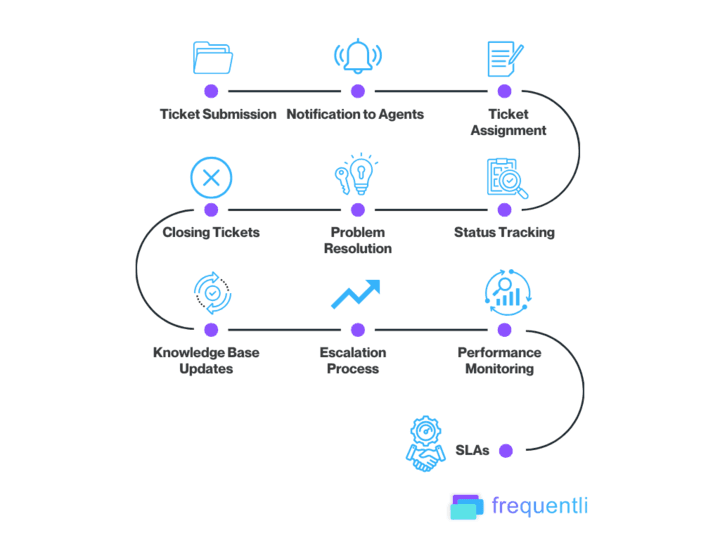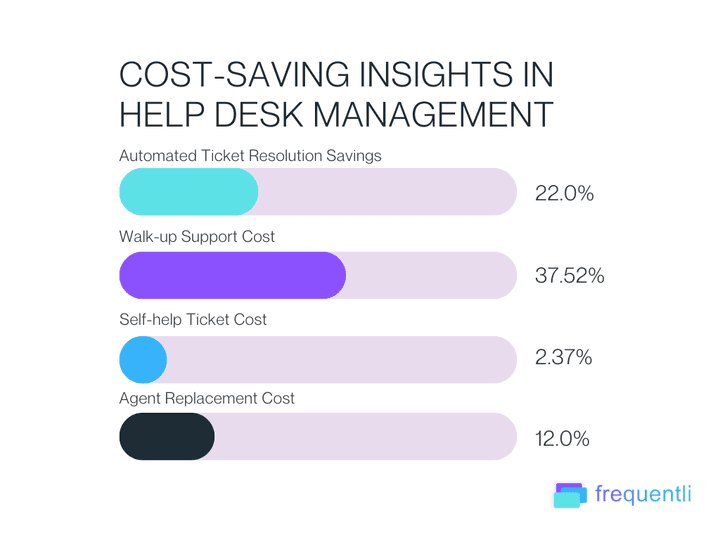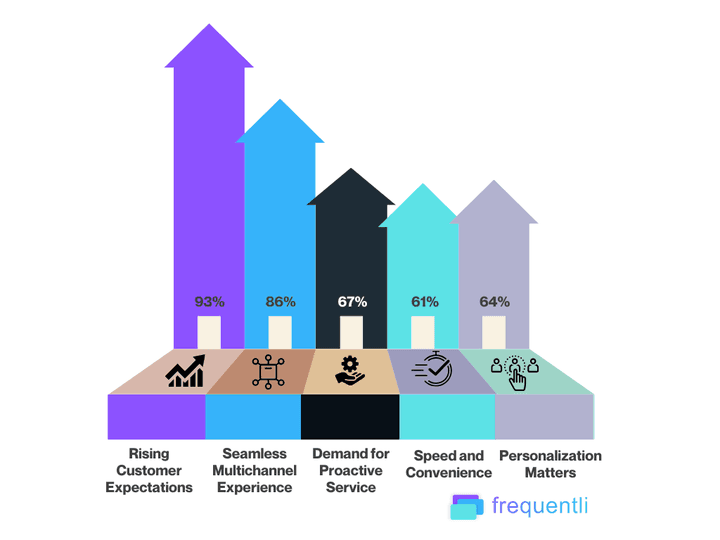Help Desk Management: Definition, Key Functions and Benefits
Help desk management is often the frontline of customer interaction, but it’s also where companies can stumble. Long wait times, confusing processes, and unresolved issues can turn a simple request into a frustrating customer experience.
No one likes dealing with complicated support systems; they want quick and easy solutions.
In this blog, we’ll dive into what help desk management is, break down its key functions, and explore the many benefits of having a well-structured help desk system. By the end, you’ll understand how an optimized help desk can reduce customer frustration and lead to happier, more loyal clients.
What is Help Desk Management?
Help desk management is all about organizing and overseeing customer support operations. It involves tracking customer inquiries, ensuring prompt responses, and resolving issues effectively through a ticketing system.
At its core, help desk management aims to:
Improve customer satisfaction
Streamline support processes
Monitor overall performance
Ticket management, service level agreements (SLAs), and effective customer communication are essential components of a help desk system.
Help Desks are User-Centric
A well-run help desk is all about the user. The primary goal is to resolve issues efficiently without making users jump through hoops.
According to the ITIL (Information Technology Infrastructure Library) framework, one of the most widely used standards in IT service management, the primary purpose of a help desk is to restore normal operations as quickly as possible with minimal disruption to the user.
From the user's point of view, they don’t care how tickets are tracked or how SLAs are managed—they just want their problem solved.
First Contact Resolution (FCR), which refers to solving the issue on the first interaction, is a critical metric that significantly impacts user satisfaction.
Actionable Tip: Consider offering self-service options, such as Frequentli.ai or AI-powered chatbots, to resolve common issues without involving an agent. This frees up your team and speeds up the resolution process for users.
Also check out What is Average Agent Response Time & How to Reduce it
The Role of Emotional Intelligence in Help Desk Communication
Customer service is more than just fixing problems—it’s about how you communicate. A help desk with high emotional intelligence can significantly improve the customer experience by making users feel heard and understood.
Research from the Service Desk Institute found that 86% of users are more likely to rate their help desk experience positively when they feel that support staff truly listened to their concerns. Agents who practice active listening, show empathy, and provide clear solutions leave a lasting impression.
Actionable Tip: Train your support team in emotional intelligence techniques. Simple actions like acknowledging the user’s frustration or thanking them for their patience can improve the overall experience.
Key Functions of Help Desk Management
Let’s break down the main functions of help desk management that keep your customer support running smoothly:
1. Single Point of Contact (SPOC)
A help desk is a centralized point of contact for users seeking support. This makes it easier for customers to know where to direct their inquiries and helps your business streamline interactions.
2. Ticket Management
The backbone of any help desk, ticket management involves creating, tracking, and resolving customer inquiries.
The process includes:
Ticket Creation: Logging the issue or request.
Prioritization: Assigning urgency levels based on impact.
Routing: Directing tickets to the right support agent or team.
Monitoring: Keeping tabs on ticket status to ensure timely resolutions.
Actionable Tip: Set up automated ticket routing based on issue type and agent expertise to speed up the resolution process and reduce delays.
3. Answering Inquiries
Help desks handle a variety of inquiries, from technical support to general product questions. Offering multiple channels—such as email, chat, and phone—gives customers the flexibility to reach out in the most convenient way.
4. Knowledge Base Management
Maintaining an up-to-date and easily accessible knowledge base is key to help desk efficiency. This repository of guides, FAQs, and troubleshooting articles helps customers find answers on their own and supports agents in resolving tickets faster.
Actionable Tip: Regularly review and update your knowledge base to ensure it includes the latest information and solutions to frequently encountered problems.
5. Performance Measurement
Tracking performance through Key Performance Indicators (KPIs) such as response times, resolution times, and customer satisfaction scores is crucial for ongoing improvement.
Actionable Tip: Set up real-time dashboards that display KPIs so that agents and managers can stay on top of their performance and identify areas needing attention.
6. Automation of Tasks
Automation helps lighten the load for your team by handling routine tasks. Whether it’s sending automated responses for common inquiries or using AI-driven chatbots, automation can significantly improve both speed and efficiency.
Actionable Tip: Set up automated alerts to remind agents of pending tickets, helping reduce response times and prevent issues from slipping through the cracks.
Check out Expert Tips to Automate Tedious Customer Service Tasks
7. Escalation Management
When complex issues arise, escalation management ensures that tickets are transferred to the appropriate senior agents or specialized teams. Clear protocols help maintain service quality during this hand-off.
How Help Desk Management Works: A Step-by-Step Process
Here’s a step-by-step breakdown of how help desk management works in practice:

How Help Desk Management Works
Ticket Submission: Customers submit requests through various channels (email, chat, or support portal).
Notification to Agents: The system notifies agents of new tickets.
Ticket Assignment: Tickets are assigned to agents based on skills and availability.
Status Tracking: Agents update the ticket status as they work on the issue.
Problem Resolution: The agent communicates with the customer to resolve the issue.
Closing Tickets: The ticket is closed once the issue is resolved.
Knowledge Base Updates: Solutions are documented for future reference.
Escalation Process: If necessary, the issue is escalated to a senior agent.
Performance Monitoring: The system tracks KPIs and generates reports for continuous improvement.
SLAs: Operations adhere to pre-defined service level agreements to ensure timely responses.
Top Benefits of Help Desk Management for Businesses
1. How Automation Helps Improve Efficiency
A well-structured help desk centralizes all customer inquiries, allowing teams to handle requests more efficiently. Automation tools can take care of routine tasks, reducing the manual workload and freeing agents to focus on more complex issues.
2. Why Faster Response Times Matter
Fast response times lead to happier customers. A help desk focused on resolving issues quickly improves user satisfaction and builds long-term loyalty.
3. Better Data Management and Reporting
Help desk systems collect valuable data on customer interactions, which can be analyzed to improve performance and identify recurring issues.
4. Cost Reduction Through Self-Service
Implementing self-service options like dynamic AI-powered FAQs or chatbots can significantly reduce the cost of customer support. Self-help tickets are considerably cheaper than traditional methods like phone or walk-up support.

Cost Reduction Through Self-Service Help Desks
For instance, it shows that replacing a service desk agent in North America can cost up to $12,000, making turnover expensive. In contrast, self-help tickets cost only $2.37 on average, significantly cheaper than walk-up support, which costs $37.52 per ticket. (HDI, 2021).
Additionally, 22% of total service desk tickets are resolved through automation at no cost, underscoring the financial benefits of implementing self-service and automated solutions in help desk operations.
5. Proactive Problem Solving
By monitoring trends and customer data, a proactive help desk can identify potential issues before they escalate, reducing downtime and improving service continuity.
6. Scalability
As your business grows, so will the volume of customer inquiries. A scalable help desk system ensures that your team can handle increased demand without sacrificing quality.
7. Improved Collaboration
Help desk platforms with collaboration tools enable teams to work together on complex issues, leading to faster resolutions and better outcomes.
8. Compliance and Security
A well-managed help desk helps ensure customer data is handled securely and complies with regulations like GDPR and HIPAA.
Help Desk Challenges in 2024

Rising Help Desk Challenges in 2024
Despite these benefits, businesses still face new challenges in help desk management. In a data by Desku.io, customers expect faster, more personalized support and 93% of service teams report these expectations are at an all-time high.
Customers expect smooth transitions between communication channels (86%) and brand proactive engagement (67%). Speed and convenience are also key, with 61% prioritizing quick resolutions.
Moreover, 64% of consumers feel undervalued when interactions lack personalization. So it’s clear that for businesses to stay competitive, they must focus on faster, more personalized service that meets these evolving demands.
